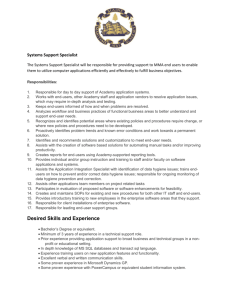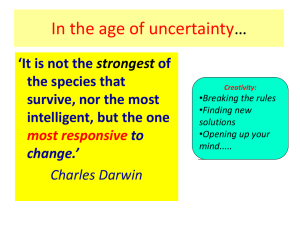Supporting Self-Experimentation of Behavior Change Strategies
advertisement
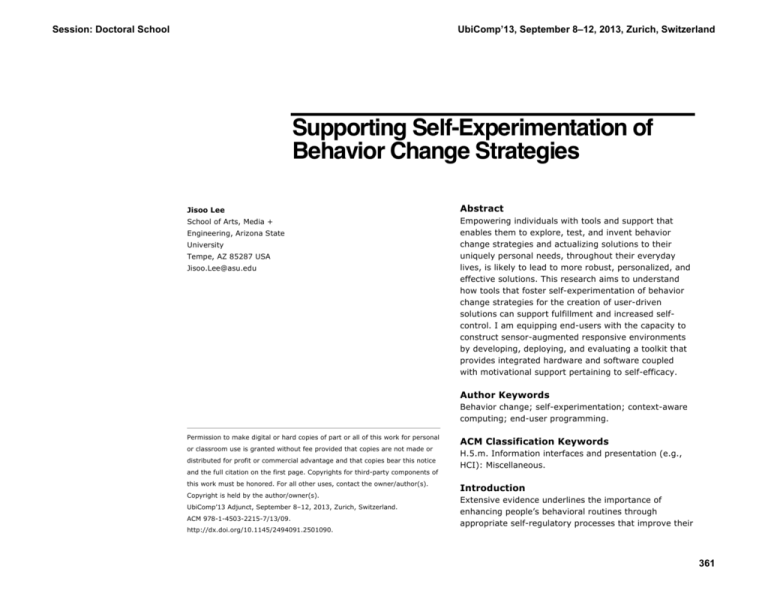
Session: Doctoral School UbiComp’13, September 8–12, 2013, Zurich, Switzerland Supporting Self-Experimentation of Behavior Change Strategies Jisoo Lee Abstract School of Arts, Media + Empowering individuals with tools and support that enables them to explore, test, and invent behavior change strategies and actualizing solutions to their uniquely personal needs, throughout their everyday lives, is likely to lead to more robust, personalized, and effective solutions. This research aims to understand how tools that foster self-experimentation of behavior change strategies for the creation of user-driven solutions can support fulfillment and increased selfcontrol. I am equipping end-users with the capacity to construct sensor-augmented responsive environments by developing, deploying, and evaluating a toolkit that provides integrated hardware and software coupled with motivational support pertaining to self-efficacy. Engineering, Arizona State University Tempe, AZ 85287 USA Jisoo.Lee@asu.edu Author Keywords Behavior change; self-experimentation; context-aware computing; end-user programming. Permission to make digital or hard copies of part or all of this work for personal or classroom use is granted without fee provided that copies are not made or distributed for profit or commercial advantage and that copies bear this notice and the full citation on the first page. Copyrights for third-party components of this work must be honored. For all other uses, contact the owner/author(s). Copyright is held by the author/owner(s). UbiComp’13 Adjunct, September 8–12, 2013, Zurich, Switzerland. ACM 978-1-4503-2215-7/13/09. http://dx.doi.org/10.1145/2494091.2501090. ACM Classification Keywords H.5.m. Information interfaces and presentation (e.g., HCI): Miscellaneous. Introduction Extensive evidence underlines the importance of enhancing people’s behavioral routines through appropriate self-regulatory processes that improve their 361 Session: Doctoral School UbiComp’13, September 8–12, 2013, Zurich, Switzerland health and wellness [14]. Recognizing such importance, significant exploration has been carried out to better understand the underlying mechanisms of selfregulation [8]. As the trend towards technologyenriched home environments progresses, researchers in UbiComp are increasingly exploring the use of technology to promote behavior change in various domains, such as physical health, affective stability, and energy conservation. However, through literature review I have identified two significant limitations. First, even though the cues-to-action technique [11] has been recognized as one of the most important strategies in behavior change [5], it has been underexplored in proposed Ubiquitous computing systems, in contrast to other more frequently employed techniques such as self-tracking [9]. Considering the crucial role of contextual cues in habit formation [17], I thus identify the application of cues-to-action technique within UbiComp systems to be a fruitful area of inquiry for developing effective interventions [7]. Secondly, most UbiComp research is about proposing pre-fabricated solutions for target behaviors, with little attention to user’s self-experimentation of alternative strategies. However, the combination of a particular behavior with contextual cues is idiosyncratic. Even though more comprehensive solutions to promote behavior change may be effective [2], it is very likely that no one solution will be effective for everyone. Although there has been considerable research on enduser programming tools for creation of context-aware applications [3], little attention has been given to provision of toolkits focused on behavior change. Doing so will likely involve addressing user needs and situations that are quite distinct from the ones currently approached by existing smart home control and home automation systems [6]. Von Hippel’s approach to Democratizing Innovation, argues that experts and organizations that have expertise and unique resources (e.g., UbiComp systems and design skills) can foster innovation by developing and supporting toolkits that effectively transfer the organizations capabilities and their “Sticky Knowledge” to the lead users and their contexts (e.g. end-users, in their homes). He asserts that these users are often in a unique position to develop more effective and innovative solutions than the experts as they have a more comprehensive understanding of and deeper vested interest in solving their own problems [16]. I am developing a toolkit that fosters selfexperimentation of behavior change strategies for the creation of user-driven solutions, and investigating if user’s self-experimentation with the proposed toolkit can promote behavior for a personally salient homebased behavior (i.e., sitting/TV watching, snacking, or flossing). I am addressing the following research questions through formative field work, iterative design processes involving field deployment of prototypes, and evaluation: (1) What are essential programming elements in user’s creation of applications for their behavior change? (2) What is user’s process in planning behavior change interventions? (3) How can a toolkit holistically support self-experimentation of behavior change interventions? (4) What is the value of selfexperimentation in people’s behavior change? 362 Session: Doctoral School 1. The technological platform used for my research enables rapid prototyping of simple rule and event-based systems that include physical sensing, data storage, and media event components [7]. 2. An exemplar scenario is that when a person enters the bathroom after 9 P.M, a system plays silly sound effects to invite him to brush his teeth. Screen shot of GaLLaG Strip [10]. UbiComp’13, September 8–12, 2013, Zurich, Switzerland This research provides several contributions. The proposed toolkit can help people’s pursuit of health behavior, desired results of which can save personal and social cost. Secondly, the toolkit can serve as an easy-to-use implementation technology for researchers in behavioral health and related fields. With a tool that is simple but adaptive to behavior change, technologyaugmented interventions can be tested and adapted relatively easily. Third, I am conducting field-testing to examine the usefulness of the toolkit in people’s everyday lives and homes. To the best of my knowledge, there have been no field tests that deployed end-user programming tools for creation of context-aware applications within users’ homes. This may be partially due to complicated issues in adapting systems to the dynamic nature of the end-users, who often live in dynamic heterogeneous environments. Overcoming these challenges with generalizable strategies will be an additional research contribution. Findings from Preliminary Research My preliminary work can be divided into: (1) a formative field study with participant-conceptualized/ researcher-implemented systems involving seven participants for one to four weeks of deployment at their homes; and (2) development of a visual programming tool and a study involving user testing of it, with 36 participants for a 1.5-hour session, in a labbased simulated home setting. In the initial study, after being introduced to a novel smart home technology and scenario1, participants created their own application scenarios2, addressing issues that they considered significant in their daily lives through appropriate application of the smart home technology. Systems were then developed and configured to realize these scenarios. In the second study, the visual programming tool, GaLLaG Strip [10], was developed and tested with end-users who had no programming skills or prior programing experience. After a brief introduction, users defined their applications in a linear fashion, using simple if-then conditions. Participants were asked to conceive and implement their own applications. Through these studies, I investigated the following questions: (1) Do context-aware cuing applications have an impact on people’s behavior change? (2) Is it beneficial for users to create their own behavior change solutions? (3) Can users produce applications in a manner that achieves satisfactory outcomes through enjoyable processes? With respect to the first question, I observed both encouraging results and problematic aspects with regard to the effect of cues-to-action applications in improving target behaviors. Some participants showed better performance, but some did not comply with cues given by systems. Beyond their lack of willpower, the degree of difficulty or required effort to complete a target activity greatly affected people’s compliance. For example, a participant who showed distinctive progress in taking vitamin pills compared to her previous performance, failed in her next objective, in which she was going to spend an hour on studying a foreign language. Two participants (with the goals of “learning how to play ‘Blackbird’ on my guitar” and “writing an autobiography”, respectively) explicitly expressed their increased stress, as the system’s presence exerted a pressure to engage; these participants expressed a feeling of guilt, when they did not comply. With respect to the second question, participants’ diverse objectives (ranging from sleeping on time to 363 Session: Doctoral School UbiComp’13, September 8–12, 2013, Zurich, Switzerland completing an autobiography) and different behavior change tactics employed (e.g., rewards, punishments, priming, smooth transition) were made possible by GaLLaG Strip, a tool for end-user scenario-creation. Users demonstrated different preferences toward behavior change tactics. For example, a participant was willing to prohibit her Internet use as a punishment, however, another participant did not want to be reminded about her failure at all. 3. Resnick, et al. [12] emphasized the importance of simplicity as one of the key design principles for creativity support tools, asserting that reducing the number of features can actually improve the user experience (in the context of their observation of development of a Programmable LEGO Brick in the mid-1990s). With respect to the third question, most participants easily understood how to program applications with the GaLLaG Strip programming tool; were able to create the applications that they desired, after watching a short instructional video; and were highly engaged in the experience. However, users differed with respect to their satisfaction toward their outcomes. While some people generated applications involving different patterns and interactions, others simply repeated a pattern of a given sample application. They expressed their discomfort with their outcomes (e.g. “Though I feel I can make it better, I don’t know what I can do more.” “I know there are many more things that can be done, but I only made it like this.”). Some people may need further support to guide their planning in ways that go beyond facilitating their implementation and to enhance richer explorations, especially during the startup phase. Furthermore, such guidance may also be necessary for users to attain outcomes that are more effective in terms of their behavior change. In these studies, the frustration with behavioral outcomes may have largely resulted from people’s selection of inappropriate strategies. For example, a person may have failed in setting an achievable goal [1]. Outstanding Issues From these studies, I have identified two primary issues that guide the iterative development of the toolkit: (1) How to design construction affordances that foster user’s creation of diverse implementations but which are still easy to use; and (2) How to guide user’s exploration to realize rich and meaningful solutions. Balancing between simplicity and expressiveness Expressiveness, being able to produce a wide range of application types, and ease of use and ease of learning are frequently primary concerns in developing end-user programming tools [6]. As a tool for non-expert users, Resnick, et al. weighted simplicity over functionality3, limiting, as noted by Von Hippel, the possible complexity and diverse expressiveness of the system [16]. However, for the realization of effective UbiComp behavior change scenarios it is important to balance simplicity with expressiveness, in ways that prioritize end-users capacity to create wide range of experiences. Supporting creativity In these studies, participants were uncomfortable with their limited ability to explore and implement a wide range of interventions (e.g., when they engaged in slight or repetitive re-implementation of a given sample application). To the best of my knowledge, there is no research that recognizes the need to support user’s ideation involving toolkits for end-users’ creation of context-ware applications. One reason may be that existing UbiComp approaches tend to address the most apparent problems and apply a range of relatively straightforward solutions for them. However, in moving beyond today’s smart home applications, to the realm of behavior change, we encounter, so-called, ‘wicked’ problems [13], requiring stakeholders to exert more 364 Session: Doctoral School UbiComp’13, September 8–12, 2013, Zurich, Switzerland resourceful and nuanced approaches to problems. Shneiderman [15] highlights the need to integrate creativity support within the design of systems and interfaces, and his work provides strategies that I am incorporating to support end-user creativity to realize rich, meaningful, and effective UbiComp behavior change exploration and implementations. Current and Proposed Research I am addressing the two primary issues, balancing functionality and enhancing creativity, described in the previous section. First, as an attempt to optimize programming capability for people’s behavior change, I am analyzing the application scenarios generated in the initial field studies. I have identified several rule patterns that appear frequently in the collected scenarios, but which cannot be programmed with the current programming elements of the present GaLLaG Strip. Most saliently, these rule patterns involve temporal relationships between activities (e.g. “if I have not left home within 30 minutes after waking up in the morning…”). There have been several end-user programming tools that provide some programming elements for temporal relationships [3][6]. However, expanded elements are necessary to express elaborate time-related rules found in the collected scenarios. Secondly, recognizing that people’s ideas arise from reflection on their behavior and situations and that one of the key elements for creativity is utilizing a knowledge base [4], I plan to support user’s ideation via provision of the following resources: (1) Collected personal behavioral data, (2) existing behavior change techniques, and (3) general design ideation techniques. Self-tracked behavioral data may facilitate user’s reflection on their daily life. By incorporating behavior change techniques that have been validated through scientific study, end-users will be more likely to develop more effective plans. Providing general strategies for existing ideation techniques that yield operational solutions, may foster creative thinking and outcomes. I am designing a web portal focused on rapidly distilling lessons from behavioral science (e.g., most effective strategies for promoting behavior change via context), HCI research (e.g., design thinking processes to foster creative solutions to personal problems), and personal data. Prior to development of the proposed toolkit with full working functionality, I am refining the design of user interface of programming and ideation support through laboratory and field pilot testing to ensure usability and usefulness. This summer, I am conducting an experiment to determine if a proposed toolkit promotes behavior change better than self-tracking only (i.e., 2 conditions, N=20, 10 per condition, 1-week baseline, 4week intervention with staggered recruitment). Acknowledgements I am conducting my dissertation research under the guidance of Winslow Burleson, Assistant Professor of Human Computer Interaction at the School of Computing, Informatics, and Decision Systems Engineering, at Arizona State University. My research is also guided by Eric Hekler, Assistant Professor at the School of Nutrition and Health Promotion, at Arizona State University. I would like to thank them for their support. 365 Session: Doctoral School UbiComp’13, September 8–12, 2013, Zurich, Switzerland References [1] Baumeister, R. F., Heatherton, T. F., & Tice, D. M. Losing control. San Diego, CA: Academic Press (1994). [2] Consolvo, S., McDonald, D.W., et al. Activity Sensing in the Wild: A field trial of UbiFit Garden. HFCS. (2008). [3] Dey, A., Sohn, T., Streng, S., Kodama, J. iCAP: Interactive prototyping of context-aware applications. Proc. PerCom 2006, (2006), 254–271. [4] Feldhusen, J. F. Creativity: the knowledge base and children. High Ability Studies 13, 2 (2002), 179-183. [5] Fogg, B. J. Persuasive Technology: Using Computers to Change What We Think and Do. Interactive Technologies (2002). [6] García-herranz, M., Haya, P., Alamán, X. "Towards a Ubiquitous End – User Programming System for Smart Spaces". Journal of Universal Computer Science, vol. 16, no. 12 (2010), 1633-1649. [7] Hekler, E.B., Burleson, W., Lee, J. A DIY selfexperimentation toolkit for behavior change. Published & Presented via the Personal Informatics in the Wild: Hacking Habits for Health & Happiness at the ACM-CHI Conference, 2013. http://personalinformatics.org/chi2013/hekler [8] Karoly , P. Mechanisms of self-regulation: A systems review. Annual Review of Psychology, 44, 23 (1993), 23-52. [9] Klasnja, P., Consolvo, S., Pratt, W., Informatics, H., & Seattle, I. L. How to Evaluate Technologies for Health Behavior Change in HCI Research (2011), 3063–3072. [10] Lee, J., Garduño, L., Walker, E., Burleson, W. A Tangible Programming Tool for Creation of ContextAware Applications. In Proc. of the 2013 ACM Conference on Ubiquitous Computing. ACM (2013), 110. [11] Medynskiy, Y., Yarosh, S., & Mynatt, E. Five strategies for supporting healthy behavior change. In Proc. of the 2011 annual conference extended abstracts on Human factors in computing systems - CHI EA ’11, 1333. [12] Resnick, M., Myers, b., Nakakoji, K., et al. Design Principles for Tools to Support Creative Thinking. In Proc. of the NSF Workshop on Creativity Support Tools (2005), 25-36. [13] Rittel, H. W., & Webber, M. M. Dilemmas in a general theory of planning. Policy sciences 4, 2 (1973), 155-169. [14] Sentcal, C., Nouwen, A., & White, D. Motivation and Dietary Self-Care in Adults With Diabetes: Are SelfEfficacy and Autonomous Self-Regulation Complementary or Competing Constructs?, Health psychology 19, 5 (2000), 452–457. [15] Shneiderman, B. Creating Creativity: User Interfaces for Supporting Innovation. ACM Transactions on Computer-Human Interaction 7, 1 (2000), 114–138. [16] von Hippel, E. Democratizing Innovation. The MIT Press (2006). [17] Wood, W. and Neal, D.T. A new look at habits and the habit-goal interface. Psychol Rev 114 (2007), 843– 863. 366
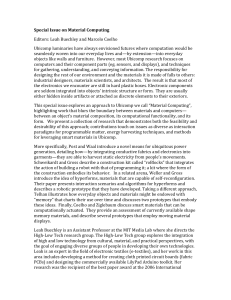


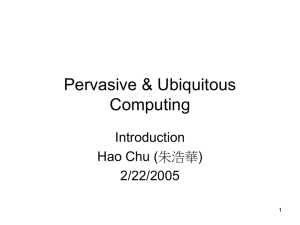

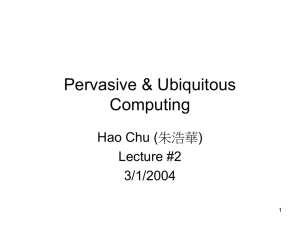
![Service Coordination Toolkit Transition Planning Checklist [ DOC ]](http://s3.studylib.net/store/data/006933472_1-c85cecf2cfb8d9a7f8ddf8ceba8acaf8-300x300.png)
